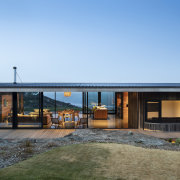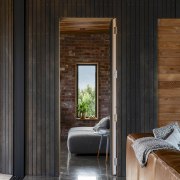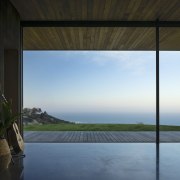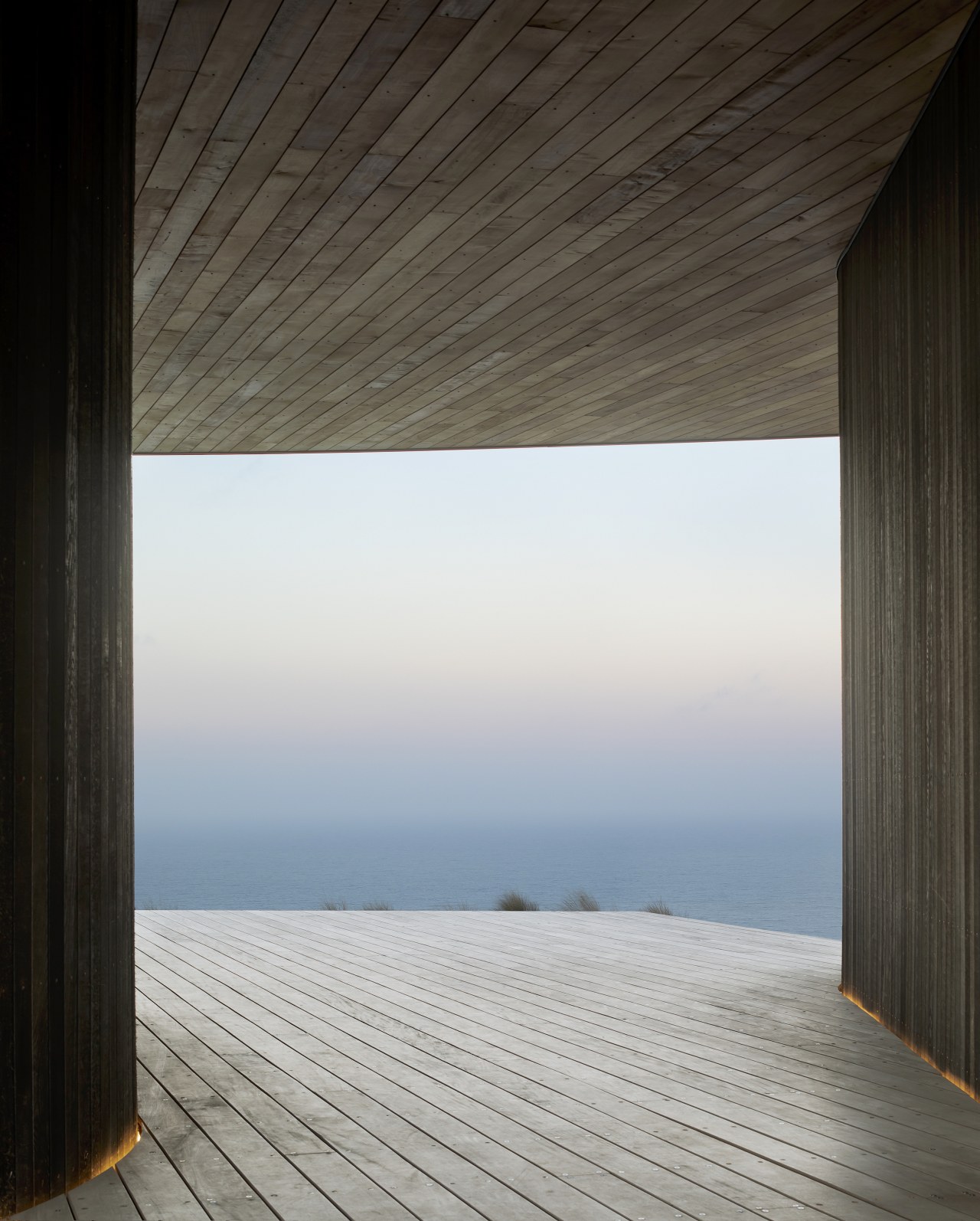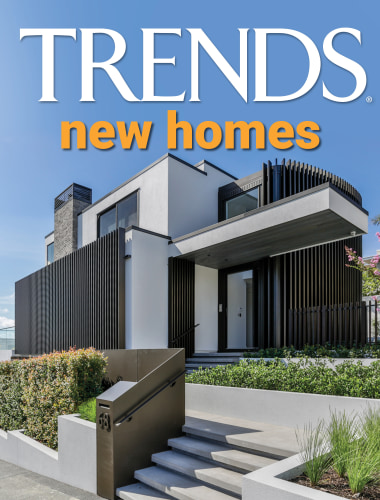House on a rock
This hilltop home is a response to its setting – three pods, a central living area, over-arching roof and encircling deck comprise a sustainable design open to land and sea
Designed by Ken Powrie, South by Southeast Architects
From the owner/architect:
Project’s site and context:
The site is located within the Port Hills which are a range of hills in Canterbury, New Zealand, so named because they lie between the city of Christchurch and its port at Lyttelton.
They are an eroded remnant of the Lyttelton volcano, which erupted millions of years ago.
Despite the heavy deforestation and clearance of native bush that took place during early settlement, a diverse range of wildlife and plant life populates the Port Hills.
Native birds such as the bellbird (korimako or koparara) fantail, silvereye, grey warbler and shining cuckoo are commonly found in the remaining bush.
Indigenous plant species such as Banks Peninsula hebe inhabit rock crevices along with rare ferns.
The more exposed hillsides are covered with silver tussock and other native grasses, unusually so for an area so close to urban development.
The site is North facing with a topography that has a 3m bank running up from the roadside to a natural plateau.
There are prominent volcanic rock seams that run through the site.
The Port Hills and the South Pacific Ocean are the dominate natural features, with views to out to the Bar (surf break) and back to Sumner Ridge.
The prevailing winds are NE / E which can quickly cool down a sunny day, with the SW proving the potential for a very strong wind coming over the ridge from Lyttleton.
The colour palette of the site is unique with the volcanic rock, native grasses and ocean providing a strong place-based character.
Constraints:
The site's natural setting provided both constraints and opportunities that directly drove the design brief and final outcome.
The strong view lines to the Southern Ocean and Port hills needed to be carefully integrated.
The extend of the volcanic rock seam running through the site was an unknown and something that needed to be dealt with once excavations started.
This was one of the site constraints that we altered the design around to take advantage of the opportunity it provided.
As the site is exposed to the majority of wind directions, the design needed to provide a variety of external areas orientated differently from each other to provide shelter from all wind directions while also capturing the sun through the day.
Each of these elements needed to be addressed through the design response so that the end result sat comfortably within the environment while forming a warm open and inviting home to live in.
Brief and design response:
The brief for the site sits within the reason for buying the site and why we as a family decided to make Christchurch our new home.
The character of the Sumner community combined with the surrounding landscape provided a unique setting that we fell in love with and which we developed the brief around.
As a family we had developed a strong connection to the surrounding landscape from sea to hills and the brief was to develop a design that reflected that connection and delivered a design driver that sat easily within the surrounding context.
The unique cues derived of place were used to drive layout, materiality, and form.
The key elements that drove our exploration are set out below.
Design brief
- To capture the light quality & moments unique to this site
- Material pallet, texture & colour driven from the natural context
- Passive design
- Use of the existing volcanic rock formations
- Connected to the specific landscape & views & community
- Sheltered by nestling into the existing contours to provide shelter and connection to the ground plane
- Provide a home where we as a family were able to easily come together
As noted above, the design response was derived out of our family’s connection to the site.
The form of the roof and deck are taken from the topography of the site where both horizontal and vertical relationships were taken into account to provide a building form that sweeps down to meet the landscape of the Port Hills while opening up to the north as it looks out to the Southern Ocean.
The three pods that shelter under the sweeping roof plane create framing points where views are orientated to the North (the sea) and to the South (Ports Hills).
The sweeping roof form and the curved pods combine to create ‘sheltered’ and ‘open’ spaces to live amongst.
The roof line comes up from the ground plane to the south to sail over the living pods and the open spaces that are created in between the pods, providing an open central living area that connects to the leading views.
The rear of the house sits into the landscape, with the roof and deck hugging the existing volcanic rock seams to provide a series of different spaces to occupy.
The eves provided by the roof provide very specific orientated shading to achieve optimum passive solar gain.
Material selection
Material selection for our house was discussed & debated at length and was an important design aspect for us.
The different timber cladding used on soffits, walls, and deck were carefully chosen to work with the colours found within the surrounding landscape and to provide a sense of warmth, human scale and contrast within the spaces.
The different timber selections also allowed us to play with textures & colours that changed with the play of light through the day and through the seasons, creating surfaces with an inherent dynamic nature.
We sourced recycled brick to line the internal faces of the pods, creating a sense of shelter and permanence while also giving a sense of a past history and reuse.
The bricks accentuated the curves of the pods with the hand of the craftsperson embedded in the finish.
The depth created in the wall cavity because of the internal brick also provided us with the opportunity to work with highly skilled joiners to craft deep timber reveals for the window and doors that created a strong sense of transition between spaces.
Method of construction
Construction methodology for this project was based around people.
From brickwork, carpentry, internal joinery to the person driving the digger exposing the rock formations, we looked for people that shared a love of their craft and who were passionate about what they do.
This type of collaboration brought lots of different perspectives together that helped drive the design throughout the entire build process.
Sustainability informing design
Key design decisions included building efficient layouts, a high performing thermal envelope, efficient space heating though passive solar gain and healthy and sustainable materials selections.
Passive design principles informed the orientation of the building along with the eve depth and location.
Effective project teamwork, communication, and early-stage incorporation of sustainable items into designs provided an incredibly robust outcome.
Materials
All materials were selected with clear sustainability benchmarks.
These benchmarks were derived by viewing sustainability from a wide range perspective points such as social, fiscal, equality, durability, cradle to grave analysis, energy efficiency, thermal, acoustic and source location.
Construction methods
Sustainable construction for us was to create a healthy environment based on ecological principles.
Sustainable construction principles that were important to use were centred around conserve, reuse, recycle/renew, protect nature, create non-toxic and high quality environments.
The goal for us was to reduce our impact on the environment by utilising sustainable development practices, employing energy efficiency, and taking advantage of green technology.
On-site methods:
- Cutting materials precisely in order to reduce waste (prefab frames)
- Controlling waste management, such as separating and recycling waste
- Constructing green buildings
- Adaptive reuse of materials
- Managing construction site to improve the environment
- Recycling food containers, etc.
- Conserving Energy
- Selecting sustainable and recycled materials
Operating systems & building performance
- Passive design principles
- Very efficient thermal envelope
- Automation operating system integrated to monitor and control the building performance
- ULB fireplace
- LED lighting
- Future for photovoltaics incorporated in main board and roof support
- Use of recycled materials that require no maintenance
- Use of timber to ensure embodied carbon is utilised
Credit list
Architect/owner
Kitchen designer
Interior design
Cladding
Wall coverings
General heating
Feature lighting – dining room pendant
Awards
Designed by: Ken Powrie, South by Southeast Architects
Story by: Trendsideas
Photography by: Sarah Rowlands
Home kitchen bathroom commercial design
Diving into nature
Personality plus
Classic looks, contemporary efficiency

